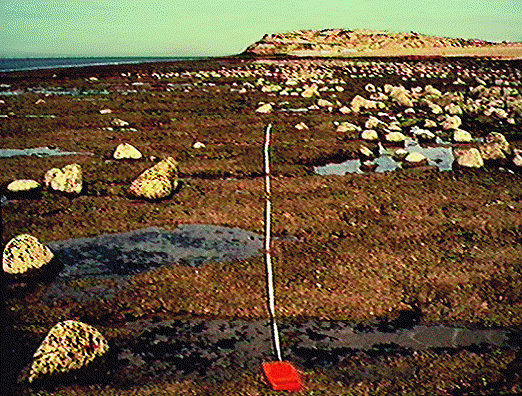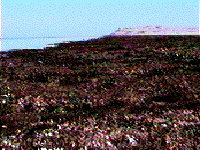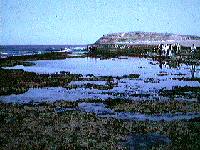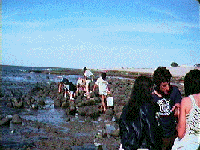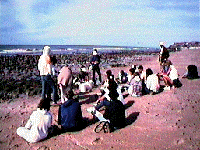Beachrock Seashore
Be sure to write about what you are learning in the lab section of your notebook. You will be expected to answer questions about the lab activity during the lab self test and lab quiz. It helps to have your text and coloring books open beside you for support.
| Refer to the Assigned Readings Below: | |
| Marine Biology Textbook | Chapter 11, pages 236 to 244 |
| Marine Biology Coloring Book | Plates 3 to 6 |
|
Beachrock Microhabitat
|
|
|
|
|
|
Observations: The intertidal platform at Playa Estacion is made up of a shell hash called beachrock. The beachrock is a relatively soft limestone that was produced geologically by the lithification of the beach deposit. It is a mixture of sand and shell held together by a calcium carbonate cement. It is light brown in color and porous. It remains relatively cool and wet at low tide. The beachrock is soft and carved by erosion. Waves and currents abrade and break it apart. It is soft enough for organisms to bore into it eroding it further. The result has been the formation of three, broad wave swept terraces. The highest terrace is partially buried in the sand of the beach that marks its shoreward edge and the lowest one slopes gently into the subtidal waters of the Gulf of California. |
|
|
Study Questions:
|
|
|
Tidepool Microhabitat
|
|
|
|
|
|
Observations: When the tide ebbs, seawater is trapped in bowl-like depressions eroded in the beachrock platform. In many cases the water will persist until the tide floods the intertidal once again. The seawater moderates the extremes that accompany exposure to the sun and air. Temperature, salinity, and moisture conditions remain more like those of the gulf. These persistent tidepools are a refuge for many delicate marine organisms. |
|
|
Study Questions:
|
|
|
Boulder Microhabitat
|
|
|
|
|
|
Observations: Basalt boulders have been deposited on top of the beachrock platform. They originate from the volcano that erupted about 30,000 years ago to form Punta Penasco which can be seen in the distance in the photograph at the top of this page. Waves strike the beach predominately from the southwest slowly nudging the boulders down the beach from their source. The boulders are very hard and organisms cannot bore into them. Waves cannot easily break them apart but they are smoothed by abrasion and occasionally rolled over by storms. The basalt is black in color and very dense. It absorbs heat but does not retain water. Boulder surfaces get relatively hot and dry at low tide but the spaces under the boulders are shaded and retain water. |
|
|
Study Questions:
|
|
|
Sandy Beach Microhabitat
|
|
|
|
|
|
Observations: The sandy beach covers the shoreward edge of the beachrock platform. The seaward portion of the sand is in the intertidal zone and is swept by waves at high tide. The shoreward portion of the sand is exposed to the sun and the air most of the time and is fringed by dunes. Beyond the dunes lies some of the driest desert in North America. The average rainfall at Puerto Penasco is less than five inches per year and temperatures during the summer are as high as those on beaches in Panama. The sand consists primarily of ground up bits of shell and beachrock and thus has a high calcium carbonate content. It is light tan in color, and is well sorted. The sand is stirred by wave action. The beach face is steep, the berm is high and the foreshore drifts slowly eastward under the action of longshore currents. |
|
|
Study Questions:
|
|
